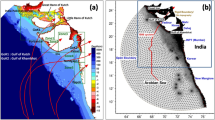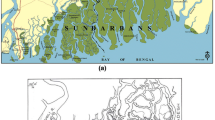Abstract
Almost every year, Bangladesh experiences disasters such as tropical cyclones, storm surges, coastal erosion or floods. Tropical cyclones originate from the North Indian Ocean and often cause devastating flood inundations in Bangladesh. Storm surges of the Bay of Bengal (BOB) are larger compared to other regions of the world for similar cyclones due to amplification by the shallow water depth, huge continental shelf and convergent coastlines. This scenario of inundation for such storm surges in the future when the sea level rise (SLR) occurs due to global warming will be different from the present. The densely populated coastal region of Bangladesh is likely to become more vulnerable in the future due to SLR. Disaster risks can be reduced if storm surges can be predicted well ahead. To assess the possible changes of inundation in the future, a widely used coastal model, Delft3D, has been applied for this BOB region. The model has been validated for the storm surge of three recent devastating cyclones, namely, Sidr, Aila and Roanu in the southern coast of Bangladesh. The validated model has been run to produce inundation maps and statistics for cyclonic storm surges such as Sidr, Aila and Roanu and probable SLR. Three possible SLR boundary conditions are chosen from the business-as-usual climate scenario representative concentration pathway 8.5 with values of 0.5 m (lower limit), 1 m (upper limit) and 1.5 m (extreme case, considering the subsidence and a rapid collapse of the Antarctic ice sheet). It is found that a category 4 cyclone such as cyclone Sidr would inundate 2.6%, 3.67% and 5.84% of the area of the country if the SLR is 0.5, 1 and 1.5 m, which will affect the livelihood of nearly 4.1, 7.0 and 9.1 million people of Bangladesh, respectively. It will also inundate up to 21.0%, 42.1% and 65.1% of the Sundarbans mangrove forest, which will undoubtedly affect the ecology of this unique ecosystem.




Similar content being viewed by others
References
Alam M S and Jabed M A 2015 Cyclones and causes of cyclones over the south west coastal area of Bangladesh; Banglavision 15(1) 91–104.
Bangladesh Bureau of Statistics (BBS) 2011 Population and housing census 2011.
Church J A and White N J 2011 Sea-level rise from the late 19th to the early 21st century; Surv. Geophys. 32(4–5) 585–602.
Dastagir M R 2015 Modeling recent climate change induced extreme events in Bangladesh: A review; Weather Clim. Extremes 7 49–60.
Elshorbagy W, Azam M H and Taguchi K 2006 Hydrodynamic characterization and modeling of the Arabian Gulf; J. Waterw. Port C.-ASCE 132(1) 47–56.
Ericson J P, Vörösmarty C J, Dingman S L, Ward L G and Meybeck M 2006 Effective sea-level rise and deltas: Causes of change and human dimension implications; Glob. Planet. Change. 50(1–2) 63–82.
Grinsted A, Moore J C and Jevrejeva S 2010 Reconstructing sea level from paleo and projected temperatures 2000 to 2100 AD; Clim. Dyn. 34 461–472.
Han W, Meehl G A, Rajagopalan B, Fasullo J T, Hu A, Lin J and Wallcraft A et al. 2010 Patterns of Indian Ocean sea-level change in a warming climate; Nat. Geosci. 3(8) 546.
Horstman E, Dohmen-Janssen C M and Hulscher S J 2013 Modeling tidal dynamics in a mangrove creek catchment in Delft3D; In: Coastal dynamics 2013, EPOC, Arcachon, France, June 2013, pp. 24–28.
Hydraulics D 2006 Delft3D-FLOW, simulation of multi-dimensional hydrodynamic flows and transport phenomena, including sediments; User manual, Delft, Holanda.
IPCC 2013 Climate change 2013: The physical science basis. Contribution of working group I to the fifth assessment report of the intergovernmental panel on climate change (eds) Stocker T F, Qin D, Plattner G-K, Tignor M, Allen S K, Boschung J, Nauels A, Xia Y, Bex V and Midgley P M, Cambridge University Press, Cambridge, UK and New York, NY, USA, p. 1535.
Islam M R 2004 Where land meets the sea: A profile of coastal zone of Bangladesh; The University Press Ltd., Dhaka, 317p.
Jevrejeva S, Moore J C and Grinsted A 2008 Relative importance of mass and volume changes to global sea level rise; J. Geophys. Res. 113 D08105.
Jevrejeva S, Grinsted A and Moore J C 2009 Anthropogenic forcing dominates sea level rise since 1850; Geophys. Res. Lett. 36 L20706.
Jevrejeva S, Grinsted A and Moore J C 2014 Upper limit for sea level projections by 2100; Environ. Res. Lett. 9(10) 104008.
Kreft S and Eckstein D 2013 Who suffers most from extreme weather events?; Global Climate Risk Index 2014, Germanwatch.
Krien Y, Mayet C, Testut L, Durand F, Tazkia A R, Islam A K M S, Gopalakrishna V V, Becker M, Calmant S, Shum C K and Khan Z H 2016 Improved bathymetric dataset and tidal model for the Northern Bay of Bengal. Mar. Geodesy 39(6), 422–438.
Krien Y, Testut L, Islam A K M S, Bertin X, Durand F, Mayet C and Ballu V et al. 2017 Towards improved storm surge models in the northern Bay of Bengal; Cont. Shelf. Res. 135 58–73.
Lesser G R, Roelvink J A, Van Kester J A T M and Stelling G S 2004 Development and validation of a three-dimensional morphological model; Coast. Eng. 51(8) 883–915.
Moss R, Babiker W, Brinkman S, Calvo E, Carter T, Edmonds J and Jones R N 2008 Towards new scenarios for the analysis of emissions: Climate change, impacts and response strategies; IPCC Expert Meeting Report.
Moss R H, Edmonds J A, Hibbard K A, Manning M R, Rose S K, Van Vuuren D P and Meehl G A et al. 2010 The next generation of scenarios for climate change research and assessment; Nature 463(7282) 747.
Ramamasy S and Baas S 2007 Climate variability and change: Adaptation to drought in Bangladesh; A resource book and training guide, FAO, United Nations, Rome.
Shrestha M L, Ferdousi N and Uddin S 1998 The impact of tropical cyclones on the coastal regions of SAARC countries and their influence in the region; SAARC Meteorological Research Centre, Agargaon, Bangladesh.
SMRC 2003 The vulnerability assessment of the SAARC coastal region due to sea level rise: Bangladesh case, SMRC publication No. 3; SAARC Meteorological Research Centre, Dhaka.
Tazkia A R, Krien Y, Durand F, Islam A S, Testut L, Papa F and Bertin X 2017 Seasonal modulation of M2 tide in the northern Bay of Bengal; Cont. Shelf Res. 137 154–162.
Tung T T, Walstra D J R, van de Graaff J and Stive M J 2009 Morphological modeling of tidal inlet migration and closure; J. Coast. Res. 56 1080–1084.
Unnikrishnan A S and Shankar D 2007 Are sea-level-rise trends along the coasts of the north Indian Ocean consistent with global estimates?; Glob. Planet. Change 57(3) 301–307.
Van Holland G, Verheyen B, Jacobs S, Vandenbruwaene W, Temmerman S, Meire P and De Schutter J 2010 Simulation of hydrodynamics and transport of fine sediments in vegetated polders with a controlled reduced tide: Pilot project Lippenbroek; In: Proceedings of the 8th International Symposium on ecohydraulics 2010 (ISE 2010): Bridging between ecology and hydraulics and leading the society’s new need – living with nature, September 2010, Seoul, South Korea, pp. 1775–1782.
Vermeer M and Rahmstorf S 2009 Global sea level linked to global temperature; Proc. Nat. Acad. Sci. USA 106(51) 21527–21532.
Warrick R A and Oerlemans J 1990 Climate change – The IPCC scientific assessment; pp. 257–281.
Water Resource Planning Organization (WARPO) 2004 Whereland meets the sea – A profile of the coastal zone of Bangladesh; Dhaka University Press Limited, Dhaka, Bangladesh.
Williams S J, Gutierrez B T, Titus J G, Gill S K, Cahoon D R, Thieler E R, Anderson K E, FitzGerald D, Burkett V and Samenow J 2009 Sea-level rise and its effects on the coast; In: Coastal sensitivity to sea-level rise: A focus on the mid-Atlantic region. A report by the U.S. climate change science program and the subcommittee on global change research (eds) J G Titus, K E Anderson, D R Cahoon, D B Gesch, S K Gill, B T Gutierrez, E R Thieler and S J Williams, U.S. Environmental Protection Agency, Washington DC, pp. 11–24.
Acknowledgements
The research leading to these results has received funding from the European Union Seventh Frame work Programme FP7/2007 -2013 under Grant Agreement No. 603864 (HELIX: High-End cLimate Impacts and eXtremes; http://www.helixclimate.eu). We acknowledge financial support from CNES (through the TOSCA projects BANDINO and SeaLevelAlk) for purchasing and collecting tidal data. We are thankful to Indo-French Cell for Water Sciences (Indian Institute of Science, Bangalore, India) for hosting SR, PS, ART, YK, FD and LT for project meetings during this study.
Author information
Authors and Affiliations
Corresponding author
Additional information
Corresponding Editor: Kavirajan Rajendran
Rights and permissions
About this article
Cite this article
Rahman, S., Islam, A.K.M.S., Saha, P. et al. Projected changes of inundation of cyclonic storms in the Ganges–Brahmaputra–Meghna delta of Bangladesh due to SLR by 2100. J Earth Syst Sci 128, 145 (2019). https://doi.org/10.1007/s12040-019-1184-8
Received:
Revised:
Accepted:
Published:
DOI: https://doi.org/10.1007/s12040-019-1184-8




